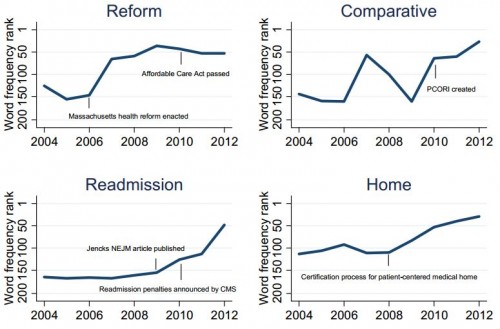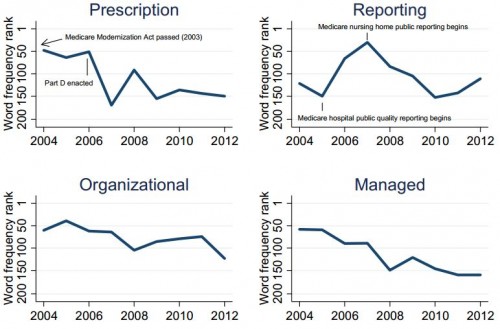Though I've missed a few, my attendance to the AcademyHealth Annual Research Meeting (ARM) goes back more than a decade. Over that span, I've noticed themes in health services research come and go, consistent with the ever changing policy landscape. But I'd be hard pressed to speak coherently on precisely how things have changed, what subjects have waxed and waned. To do that, I'd have to do some serious analysis.
But I don't have to, because Andrew Ryan and colleagues just did. Their approach was clever. They analyzed the published agendas from 2004-2012 ARMs, using software to pluck out key words. They identified the most common ones and ranked them based on frequency. They took note of what words trended up and down. What's hot and what's not?
The top five upward trending words over 2004-2012 were, in order:
- Reform
- Comparative
- Intervention
- Cancer
- Experience
The top five downward trending words were, in order:
- Managed
- Prescription
- Economics
- Financing
- Business
There were also words that stood the test of time: “improvement”, “health”, “healthcare”, “quality”, and “solution” didn't appreciably change rank over the study period.
[The figures below show] the trajectory of word frequencies for some notable words, annotated with relevant events in the field. “Reform” spiked in the frequency rankings after the passage of the Massachusetts health insurance reform and remained stable in the period preceding and immediately following the passage of the ACA. “Comparative” began the study period as a low frequency word but then surged toward the top of the frequency rankings when the Patient Centered Outcomes Research Institute (PCORI) was created by the ACA. “Readmission” similarly began the study period with a low word frequency rank, rising after the highly influential Jencks article was published and continuing to increase after the Medicare hospital readmissions penalties were announced in the ACA. The frequency of “home” was stable between 2004 and 2008, but increased rapidly after the National Committee for Quality Assurance developed accreditation standards for patient?centered medical homes. “Prescription” began the study period fairly high in the frequency rankings, but decreased in frequency during the aftermath of Medicare Part D implementation. Finally, both “organizational” and “managed” underwent fairly steady declines in frequency rankings over the study period.
(Click to enlarge)
Of course one must be careful about making inferences about the entirety of health services research from agendas from one, annual conference. But the ARM is the flagship conference of the field. If it's happening in health services research, it'll likely be found there. The conference's planning committee plays a role in defining themes. They're not random. They reflect what the committee thinks is important. And that's probably, in large part, what's policy relevant, and reflects the priorities of organizations and agencies that fund work in this area.
As you attend the conference, see if you notice any new trends. What's discussed that wasn't last year? What isn't coming up as frequently? These questions will be on my mind as I take in the sessions. I hope to see you there!
Austin B. Frakt, PhD, is a health economist with the Department of Veterans Affairs and an associate professor at Boston University’s School of Medicine and School of Public Health. He blogs about health economics and policy at The Incidental Economist and tweets at @afrakt. The views expressed in this post are that of the author and do not necessarily reflect the position of the Department of Veterans Affairs or Boston University.

